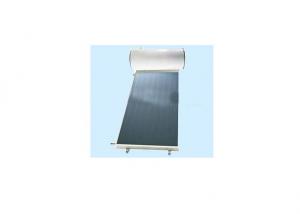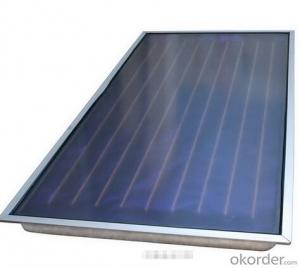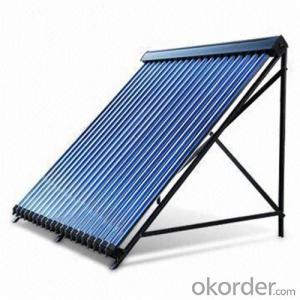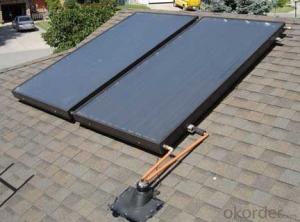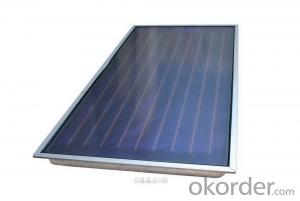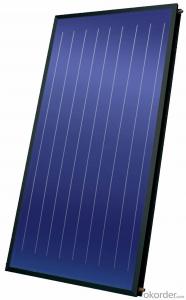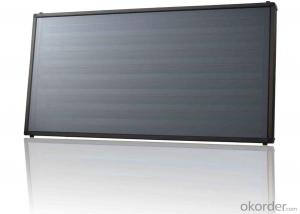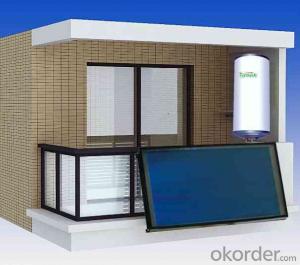CNBM Brand Solar Monocrystalline Series Panel
- Loading Port:
- Tianjin
- Payment Terms:
- TT OR LC
- Min Order Qty:
- 1 pallet
- Supply Capability:
- 100000000 pallet/month
OKorder Service Pledge
OKorder Financial Service
You Might Also Like
Solar Monocrystalline Series Panels

Product Description:
Introduction of Solar Monocrystalline Series Panels
CNBM Solar photovoltaic (PV) Panel is designed for large electrical power requirements. It is the optimal choice for both on-grid and off-grid power systems. CNBM Solar panel offers high performance of power per square foot of solar array. Monocrystalline silicon(c-Si): often made using the Czochralski process. Single-crystal wafer cells tend to be expensive, and because they are cut from cylindrical ingots, do not completely cover a square solar cell module without a substantial waste of refined silicon. Hence most c-Si panels have uncovered gaps at the four corners of the cells.
Characteristics of Solar Monocrystalline Series Panels
I Solar Cell : High efficiency crystalline solar cell. Even if under the weak light, the solar module can produce maximum power output.
II Tempered glass (toughened glass): Anti-reflecting coating and high transmission rate glass increase the power output and mechanical strength of solar module.
III EVA and TPT: Using high quality EVA and TPT to prevent destroying and water.
IV AI frame: Without screw, corner connection. 6 holes on the frame can be installed easily.
V Junction box: Multi function junction box with water proof.
VI Long lifetime: ≥25 years; Less power decrease
VII Good performance of preventing from atrocious weather such as wind and hails.
VIII Resisting moisture and etching effectively, not effected by geology.
Standard Test Conditions of Solar Monocrystalline Series Panels
The opto-electrical specifications shown below are stabilized values being measured at Standard Test Conditions, Irradiance: 1000W/m2, Spectrum: AM1.5 at 25°C, The info below is subject to manufacturing tolerances. Where appropriate minutes of measurement are available and are used for the dimensioning of the installation.
Advantages of Solar Monocrystalline Series Panels
• CNBM Solar performance guarantees for 25 years
• 12 years guarantee for workmanship
• Timeliness of delivery
CNBM International Corporation's products including Monocrystalline Solar Panel, Polycrystalline Solar Panel have received and enjoyed famous reputation in many countries and regions in the world .As a solar panel supplier in China, we strive to provide our customers with excellent service, superior products and unmatched value.
Characteristics of Solar Monocrystalline Series Panels
Max Power Voltage Vmp (V) | 18.4V | 17.6V |
Max Power Current Imp (A) | 6.52A | 7.39A |
Open Circuit Voltage Voc (V) | 23.0V | 22.2V |
Short Circuit Current Isc (A) | 6.97A | 7.90A |
Max Power Pm (W) | 120W | 130W |
Temperature Coefficient of Cells
NOCT | 47℃±2℃ |
Temperature Coefficients of Isc (%/℃) | 0.064 |
Temperature Coefficients of Voc (%/℃) | -0.33 |
Temperature Coefficients of Pmp (%/℃) | -0.45 |
Mechanical Data Solar Monocrystalline Series
Power | 120W/130W |
Dimension | 1190/1470×670×30mm |
Weight | 9.5kg/11.7kg |
Tolerance | ±3% |
The dimension of the modules can be changed according to the demand of clients
Limits
Operating Temperature | –40 °C to +85°C |
Storage Temperature | –40 °C to +85°C |
Max System Voltage | 700V |
Guarantee Solar Monocrystalline Series Panels
Products Guarantee | 10 yrs free from defects in materials and workmanship |
Performance Guarantee | No less than 90% within 10yrs and no less than 80% within 25yrs |
Certificates | IEC, ISO, TUV, CE |
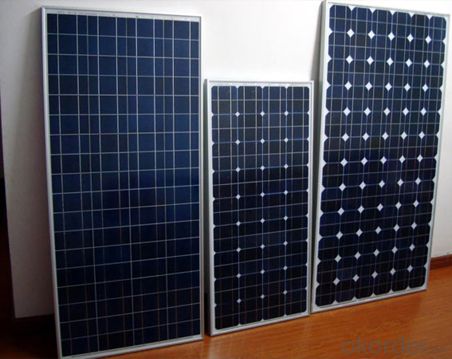
FAQ
I..Will you focus on the safety of the goods during transportation?
Yes, Safety of the cargo is the primary element that we would consider on transportation.
II..How would guarantee the quality will meet the requirements of your clients?
Before shipment, we will have inspection for each batch of goods.
III..What certificates do you have?
IEC,UL,TUV,CSA,etc.
IV..Can you do OEM according to clients’ requirements?
Yes, we have our own brand while we can provide OEM service.

- Q:Are there any issues with overheating in solar collector systems?
- Yes, there can be issues with overheating in solar collector systems. If the system is not properly designed or maintained, excessive heat can build up, which can reduce the efficiency of the system and potentially damage the components. To prevent overheating, various measures such as proper insulation, ventilation, and control mechanisms are implemented in solar collector systems.
- Q:What is the impact of dust and dirt on solar collector efficiency?
- The impact of dust and dirt on solar collector efficiency is significant as it can reduce the amount of sunlight reaching the solar panels, thereby decreasing their ability to generate electricity. Dust and dirt that accumulates on the surface of the solar collectors create a barrier that obstructs sunlight from penetrating the panels, leading to a decrease in energy production. Regular cleaning and maintenance are crucial to ensure optimal performance and maximize the efficiency of solar collectors.
- Q:Can solar collectors be installed on flat roofs?
- Yes, solar collectors can be installed on flat roofs. In fact, flat roofs are often considered ideal for solar panel installations because they provide a large, unobstructed surface area for maximum sun exposure. However, it is important to ensure that the roof structure is strong enough to support the weight of the solar collectors and to consult with a professional to determine the best installation method for flat roofs.
- Q:Can solar collectors work in cloudy or winter weather?
- Yes, solar collectors can still work in cloudy or winter weather. While their efficiency may decrease, they can still generate some amount of electricity or heat even in less optimal conditions. Additionally, advancements in solar technology have made it possible for collectors to capture and convert more solar energy, allowing them to work more effectively even in cloudy or winter weather.
- Q:Can solar collectors be used for heating in coastal areas?
- Yes, solar collectors can definitely be used for heating in coastal areas. The proximity to the coast does not affect the functionality of solar collectors, as they primarily rely on sunlight to generate heat. Coastal areas often experience ample sunshine, making them suitable for solar heating systems. Additionally, the coastal climate can provide favorable conditions for efficient heat transfer and reduced energy consumption, making solar collectors a viable and sustainable option for heating in such areas.
- Q:Can solar collectors be used in coal-fired power plants?
- Indeed, coal-fired power plants have the capability to utilize solar collectors. The primary source of fuel for these plants is coal, a fossil fuel that is used to generate electricity. However, the integration of solar collectors into these facilities can contribute to reducing the overall carbon footprint and improving energy efficiency. Within coal-fired power plants, solar collectors can be employed in various ways. One method involves the use of solar thermal collectors to preheat the feedwater prior to entering the boiler. This preheating process reduces the amount of fuel required to heat the water, resulting in decreased coal consumption and lower emissions. Another approach entails the utilization of solar photovoltaic (PV) panels alongside the coal-fired power plant to generate electricity. This additional solar power can supplement the electricity produced through coal combustion, thereby reducing reliance on fossil fuels and decreasing greenhouse gas emissions. The implementation of solar collectors in coal-fired power plants can also contribute to reducing operational costs. By harnessing solar energy, the plant can decrease its coal consumption, leading to potential cost savings over time. Furthermore, the integration of solar collectors into coal-fired power plants can serve as a transitional measure towards a cleaner and more sustainable energy system. As the world progresses towards renewable energy sources, the incorporation of solar technology into existing coal-fired power plants can act as a stepping stone towards a greener future. In summary, solar collectors can indeed be utilized in coal-fired power plants to enhance energy efficiency, reduce emissions, and decrease operational costs.
- Q:Can solar collectors be used for process heat in the manufacturing industry?
- Yes, solar collectors can be used for process heat in the manufacturing industry. Solar thermal systems can provide a sustainable and renewable source of heat energy for various industrial processes, such as heating liquids, drying materials, or generating steam. By harnessing the power of the sun, solar collectors can reduce reliance on fossil fuels, lower carbon emissions, and contribute to a more environmentally friendly manufacturing process.
- Q:Can solar collectors be integrated into existing buildings?
- Yes, solar collectors can be integrated into existing buildings. They can be installed on rooftops or walls, depending on the available space and orientation. Retrofitting solar collectors onto existing buildings is a viable option to harness solar energy and reduce reliance on traditional energy sources.
- Q:Are there any government incentives or rebates for installing solar collectors?
- Yes, many governments offer incentives and rebates for installing solar collectors. These incentives vary by country and region, but they often include tax credits, grants, low-interest loans, and feed-in tariffs. These incentives aim to promote the adoption of renewable energy sources, reduce greenhouse gas emissions, and achieve sustainability goals. It is advisable to check with local government authorities or renewable energy agencies to determine specific incentives available in your area.
- Q:Are there any government incentives for installing solar collectors?
- Yes, there are government incentives available for installing solar collectors. These incentives vary by country and can include tax credits, grants, rebates, and feed-in tariffs that encourage the use of renewable energy sources like solar power.
1. Manufacturer Overview |
|
|---|---|
| Location | |
| Year Established | |
| Annual Output Value | |
| Main Markets | |
| Company Certifications | |
2. Manufacturer Certificates |
|
|---|---|
| a) Certification Name | |
| Range | |
| Reference | |
| Validity Period | |
3. Manufacturer Capability |
|
|---|---|
| a)Trade Capacity | |
| Nearest Port | |
| Export Percentage | |
| No.of Employees in Trade Department | |
| Language Spoken: | |
| b)Factory Information | |
| Factory Size: | |
| No. of Production Lines | |
| Contract Manufacturing | |
| Product Price Range | |
Send your message to us
CNBM Brand Solar Monocrystalline Series Panel
- Loading Port:
- Tianjin
- Payment Terms:
- TT OR LC
- Min Order Qty:
- 1 pallet
- Supply Capability:
- 100000000 pallet/month
OKorder Service Pledge
OKorder Financial Service
Similar products
New products
Hot products
Hot Searches






